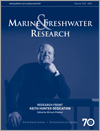Marine and Freshwater Research
Volume 71
Number 3 2020
RESEARCH FRONT: Keith Hunter Dedication
Ocean acidification (OA) is the ongoing change to seawater chemistry caused by oceanic uptake of increasing levels of atmospheric carbon dioxide. ‘Multiple drivers’ is the term used to describe the cumulative effects of multiple environmental factors on organisms or ecosystems. We propose that OA acts as a multiple driver, and discuss how simultaneously changing seawater properties interact to affect vulnerable marine life, including fish, shellfish, seaweeds, coralline algae, phytoplankton and corals.
Increasing concentrations of seawater carbon dioxide, called ocean acidification, could benefit some species of seaweed. Certain seaweed that can use only carbon dioxide, and not the more abundant bicarbonate, are prime candidates to benefit. We demonstrated that, in general, these species that can use only carbon dioxide respond positively to ocean acidification, although some variability exists among species’ responses.
The New Zealand Ocean Acidification Observing Network (NZOA-ON) has been developed to inform the scientific and economic challenges that New Zealand is facing in response to more acidic ocean waters. Remote field sites are distributed across New Zealand coastal waters to better understand how ocean chemistry is changing in response to increasing atmospheric carbon dioxide and how ecosystems will be affected.
Estuaries are complex geochemical reactors that can greatly modify the delivery of dissolved and suspended material from rivers to the ocean. Understanding how metal pollutants behave in estuarine environments is important to protecting very high environmental and socioeconomic values (e.g. fisheries and recreation). This paper reviews how salinity, particle aggregation and pH changes affect metal dynamics in estuaries.
We identified refractory dissolved organic molecules with traceable chemical signatures as the bulk of iron-biding ligands found at depth. Refractory molecules had limited bioavailability to phytoplankton. However, when upwelled and photochemically degraded, inorganic bioavailable iron was liberated, which can potentially sustain primary productivity.
CO2 vents have been proposed as potential analogues to investigate the effects of ocean acidification on natural ecosystems. Here we present a preliminary evaluation of the suitability of the temperate CO2 vents at Whakaari–White Island (New Zealand) as natural study sites in the Southern Hemisphere. We conclude that these vents represent a unique ecosystem with considerable biogeochemical complexity and recommend care in their use as a model of the future ocean.
The marine cycling of Cd is intriguing because it mimics the essential nutrient phosphorus (P), except at the subtropical convergence (STC). Here, we present a 3-year time series of field measurements of Cd and P concentration across the STC, New Zealand. Cadmium concentration exhibits extreme seasonality (50×), much larger than do other bio-utilised elements. The timing of the drawdown implies a biological role for Cd.
This study investigated the distribution of dissolved and particulate zinc and its isotopes in the Subantarctic Zone. Zinc had a longer regeneration length scale than phosphorus and cadmium, but a shorter one than copper. In addition, the isotope composition of dissolved and particulate zinc was affected by chemical (complexation), biological (uptake and regeneration), physical (mixing and particle sinking) and seasonal variations acting in concert.
This paper focuses on taxonomy and habitat distribution of groundwater copepods in South-east Asia. We list 48 species from 22 genera documented from groundwater and groundwater-dependent habitats across the region that exhibit higher local endemicity compared to regional scale. A high number of species can still be discovered if more intensive sampling efforts and collaborative work are undertaken in the future.
The dourado Salminus brasiliensis can migrate over 200 km to reproduce in the Ivinheima River and its tributaries, indicating favourable local conditions for migration and spawning. In addition, the species exhibits differential use of biotopes for reproduction, including rivers and backwaters (spawning) and lagoons (refuge and growth). The dourado is a key species for conservation, so ensuring its reproductive success means maintaining a balanced ecological structure.
The ocean wave climate of Victoria, Australia, was analysed using 31 years of hindcast data. Wave height and period are highest on the west coast, decrease within Bass Strait, then increase eastwards to New South Wales. Wave direction is most variable on the east coast. The Southern Annular Mode and El Niño–Southern Oscillation both influence wave climate and storm frequency.
This research explored, for the first time, interactions between mantas and remoras in a marine park in the Mexican Pacific. The aim was to provide general information about the preference of the remoras for this vulnerable species of mantas, because knowledge of both species is still scarce in the area. Ecological implications regarding this interaction are discussed.
 , Philip W. Boyd, Christopher E. Cornwall, Peter Croot, Kim I. Currie, Russell D. Frew, Catriona L. Hurd, Cliff Law, Peter S. Liss, Christina M. McGraw, Luke M. Mosley, Sylvia G. Sander, Claudine Stirling and Rebecca Zitoun
, Philip W. Boyd, Christopher E. Cornwall, Peter Croot, Kim I. Currie, Russell D. Frew, Catriona L. Hurd, Cliff Law, Peter S. Liss, Christina M. McGraw, Luke M. Mosley, Sylvia G. Sander, Claudine Stirling and Rebecca Zitoun




